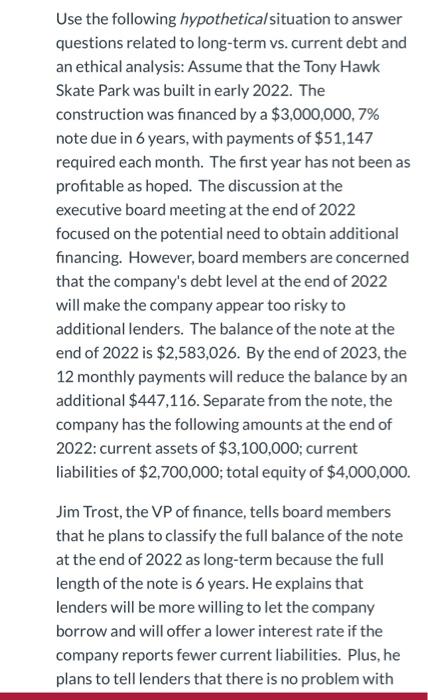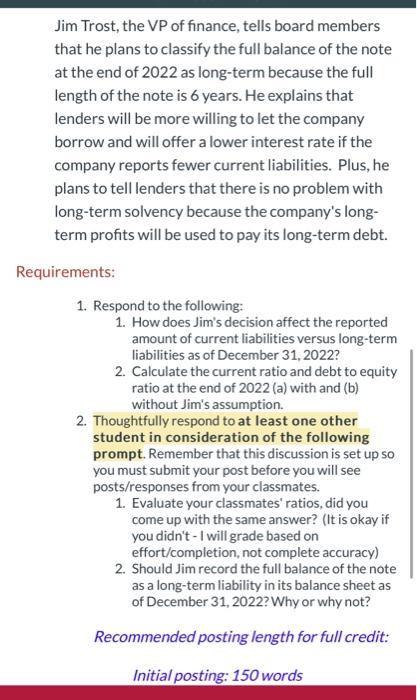Use the following hypotheticalsituation to answer questions related to long-term vs. current debt and an ethical analysis: Assume that the Tony Hawk Skate Park was built in early 2022 . The construction was financed by a $3,000,000,7% note due in 6 years, with payments of $51,147 required each month. The first year has not been as profitable as hoped. The discussion at the executive board meeting at the end of 2022 focused on the potential need to obtain additional financing. However, board members are concerned that the company's debt level at the end of 2022 will make the company appear too risky to additional lenders. The balance of the note at the end of 2022 is $2,583,026. By the end of 2023 , the 12 monthly payments will reduce the balance by an additional $447,116. Separate from the note, the company has the following amounts at the end of 2022: current assets of $3,100,000; current liabilities of $2,700,000; total equity of $4,000,000. Jim Trost, the VP of finance, tells board members that he plans to classify the full balance of the note at the end of 2022 as long-term because the full length of the note is 6 years. He explains that lenders will be more willing to let the company borrow and will offer a lower interest rate if the company reports fewer current liabilities. Plus, he plans to tell lenders that there is no problem with Jim Trost, the VP of finance, tells board members that he plans to classify the full balance of the note at the end of 2022 as long-term because the full length of the note is 6 years. He explains that lenders will be more willing to let the company borrow and will offer a lower interest rate if the company reports fewer current liabilities. Plus, he plans to tell lenders that there is no problem with long-term solvency because the company's longterm profits will be used to pay its long-term debt. quirements: 1. Respond to the following: 1. How does Jim's decision affect the reported amount of current liabilities versus long-term liabilities as of December 31, 2022? 2. Calculate the current ratio and debt to equity ratio at the end of 2022 (a) with and (b) without Jim's assumption. 2. Thoughtfully respond to at least one other student in consideration of the following prompt. Remember that this discussion is set up so you must submit your post before you will see posts/responses from your classmates. 1. Evaluate your classmates' ratios, did you come up with the same answer? (It is okay if you didn't - I will grade based on effort/completion, not complete accuracy) 2. Should Jim record the full balance of the note as a long-term liability in its balance sheet as of December 31,2022 ? Why or why not? Recommended posting length for full credit: Initial posting: 150 words Use the following hypotheticalsituation to answer questions related to long-term vs. current debt and an ethical analysis: Assume that the Tony Hawk Skate Park was built in early 2022 . The construction was financed by a $3,000,000,7% note due in 6 years, with payments of $51,147 required each month. The first year has not been as profitable as hoped. The discussion at the executive board meeting at the end of 2022 focused on the potential need to obtain additional financing. However, board members are concerned that the company's debt level at the end of 2022 will make the company appear too risky to additional lenders. The balance of the note at the end of 2022 is $2,583,026. By the end of 2023 , the 12 monthly payments will reduce the balance by an additional $447,116. Separate from the note, the company has the following amounts at the end of 2022: current assets of $3,100,000; current liabilities of $2,700,000; total equity of $4,000,000. Jim Trost, the VP of finance, tells board members that he plans to classify the full balance of the note at the end of 2022 as long-term because the full length of the note is 6 years. He explains that lenders will be more willing to let the company borrow and will offer a lower interest rate if the company reports fewer current liabilities. Plus, he plans to tell lenders that there is no problem with Jim Trost, the VP of finance, tells board members that he plans to classify the full balance of the note at the end of 2022 as long-term because the full length of the note is 6 years. He explains that lenders will be more willing to let the company borrow and will offer a lower interest rate if the company reports fewer current liabilities. Plus, he plans to tell lenders that there is no problem with long-term solvency because the company's longterm profits will be used to pay its long-term debt. quirements: 1. Respond to the following: 1. How does Jim's decision affect the reported amount of current liabilities versus long-term liabilities as of December 31, 2022? 2. Calculate the current ratio and debt to equity ratio at the end of 2022 (a) with and (b) without Jim's assumption. 2. Thoughtfully respond to at least one other student in consideration of the following prompt. Remember that this discussion is set up so you must submit your post before you will see posts/responses from your classmates. 1. Evaluate your classmates' ratios, did you come up with the same answer? (It is okay if you didn't - I will grade based on effort/completion, not complete accuracy) 2. Should Jim record the full balance of the note as a long-term liability in its balance sheet as of December 31,2022 ? Why or why not? Recommended posting length for full credit: Initial posting: 150 words








